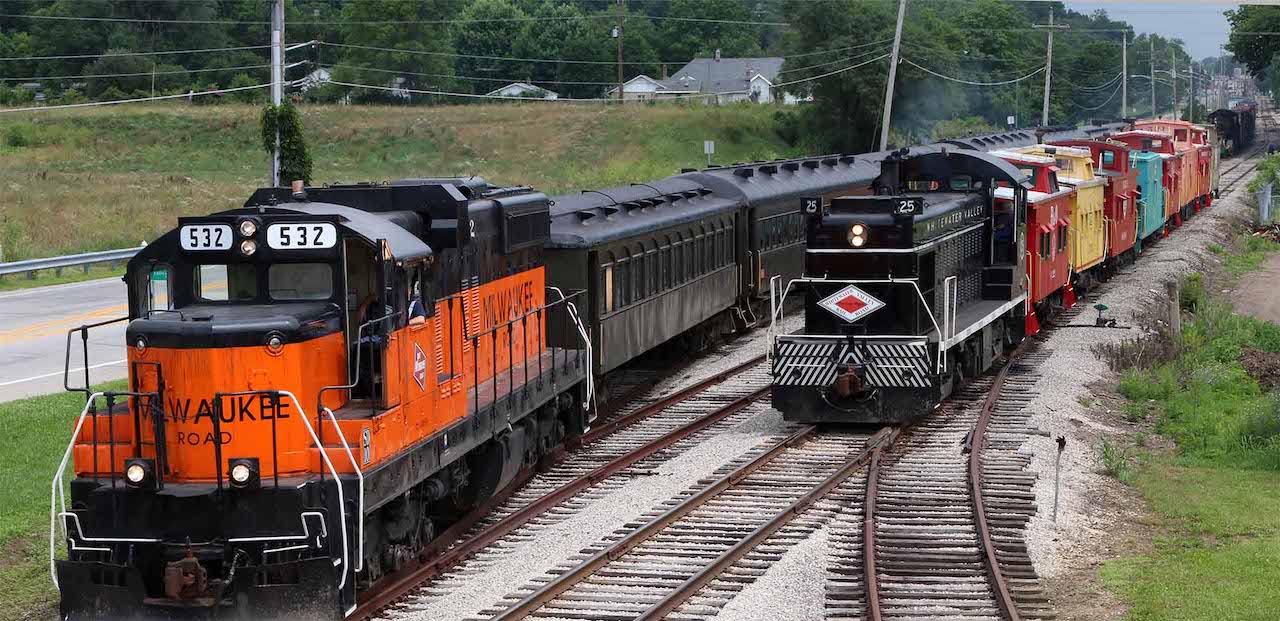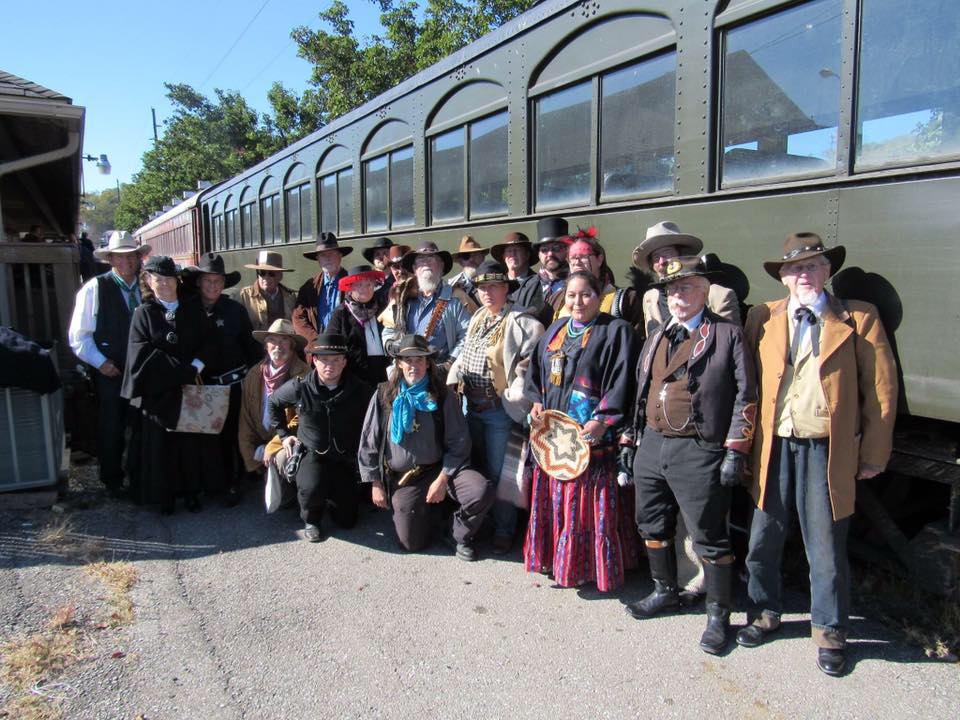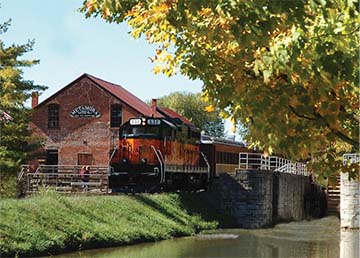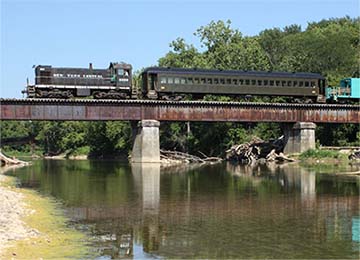
A Tourist Railroad and a Canal Segment Provide a Glimpse Into Indiana History
Written by David Peter Alan, Contributing Editor
WVRR photo
We normally don’t write about “tourist railroads” here at Railway Age; in part because many are isolated and not accessible by any other form of non-automobile transportation. Yet there is an exception in southeastern Indiana, about half-way between Cincinnati and Indianapolis. It’s even accessible on Amtrak, at least for hearty travelers who are willing to put up with Amtrak’s schedule.
It’s the Whitewater Valley Railroad (WVRR), which runs 18.2 miles along the historic Big Four Route between Connersville and the historic canal town of Metamora. On the day I was there, May 6th, the railroad was celebrating the start of its 50th season. Trains run on weekends, leaving Connersville at noon, allowing a two-hour layover in Metamora, and returning to Connersville at 5:00 p.m. Some of the excursions have a theme, like Civil War history or the Wild West, but the season opener was a more-conventional run. There was no need to run a themed train or a special consist; everybody concerned was excited to see the train come back for another season.

Connersville was once a busy town, served by three railroads. Amtrak’s Cardinal uses the historic Baltimore & Ohio (B&O) line, and CSX uses the former passenger station for its freight-related purposes. The Big Four, which was part of the New York Central for most of its existence, went through Connersville, too. So did the Nickel Plate, but that line was taken up years ago. The town’s history goes back to 1813.
Metamora, at the other end of the line, was a canal town at first. The Whitewater Canal was built between 1836 and 1847, reached Connersville in 1845, and was originally 76 miles long. The canal was soon superseded by the railroad, though, and the original WVRR was built along the towpath of the old canal starting in 1863 and reached Connersville in 1867. Today, Metamora celebrates the old canal by keeping water in the part of it that lies in town and holding celebrations like Canal Days in early October.
The current railroad is owned by a not-for-profit corporation. It runs heritage excursion trains, but no freight. John Hillman, President of the railroad, has been there since the beginning, when the excursions began in 1974. It was purchased from Conrail who, as Hillman said: “dumped some boxcars in the canal, packed up, and went home.” Still, it was not officially abandoned, even though Penn Central had taken it out of service during that company’s brief existence. The Whitewater Valley leased the line at first, but was later faced with a “buy it or we’ll rip it up” ultimatum and bought it; obtaining it for scrap value. The railroad receives no money from the State of Indiana (which withdrew funding from the Amtrak Hoosier State in 2019, resulting in that train’s demise).

Today the trains run from MP 68.8 to MP 50, measured from Cincinnati. The trip between Connersville and Metamora is called the Valley Flyer and is numbered #1 from Connersville and #2 returning. In addition, there is a “local” train running within Metamora with several round trips along the canal during the afternoon. The station in Connersville is called “Grand Central Station” for a reason that has nothing to do with New York City. Rather, it is located on the local Grand Central Avenue.
The consist from Connersville included Engine #25, a 1951-vintage switcher built by the Lima Locomotive Works, which originally moved equipment around the Cincinnati Union Terminal. That facility now hosts only the Cardinal on its tri-weekly rambles in each direction. Of the three coaches, one was an arch-roof car that entered local service on the Rock Island in 1923 (this writer rode cars of that class in the days before Metra). The other two were Stillwell cars designed by Louis B. Stillwell for the Erie Railroad. The two in that day’s consist were built in 1926 and 1934; the older one having arched openings above its paired windows, similar to the ones that ran between Hoboken and Port Jervis until the mid-1970s (and from the old Erie Terminal in Jersey City during an earlier era).
To celebrate the railroad’s 50th anniversary (actually the start of its 50th year of service), there was a ceremony with a ribbon cutting before the train left Connersville. Council member Diana Phillips led off with one of the shortest welcoming speeches on record. She said: “Connersville and Fayette County are proud to be here on Indiana’s most scenic railroad. Congratulations, and here’s to fifty more!” Butch Bunzendahl, whose father was one of the members of the group that started the railroad was next. He said: “Their big ambition was to bring tourism back to town,” and added that the line has been an all-volunteer operation ever since. The railroad has a roster of about 200 volunteers.
Then it was time to cut the red ribbon that had been stretched across the boarding ramp. WVRR President John Hillman picked up a giant pair of scissors, made his statement consisting of: “It just keeps on getting better and better,” and did the honors. Then the small crowd of Connersville locals, including Council Members Philips and Brian Robb boarded the train for the roughly 90-minute journey to Metamora.
Conductor Rob Rogers, who also handles publicity for the railroad, provided the narration along the way. He gave some background about the canal, originally with 56 locks along its 71 miles, but the State of Indiana went bankrupt in 1839, due to flood damage. Rogers said that the canal held water until the early 1950s and gave a history of the Big Four Route, adding: “The canal was crooked, so the railroad was crooked,” and said that the curves were later banked to allow higher speeds.

During the two-hour layover in Metamora, there was time to sample some of the features of the historic canal town. The railroad also runs a local train for two miles beyond the station. It was pulled by a 65-ton switcher built by General Electric for the Navy in 1942 and designated USN-1. Behind it was a vintage car that once ran on the Chicago & North Western Railroad (C&NW) and another Stillwell car from the Erie. The WVRR claims to have the nation’s largest collection of Stillwells; five that are operational and two others that are not.
The railroad and canal are located between the two sides of Main Street in Metamora. Many of the town’s buildings date back to the canal era, or at least the early part of the railroad era. There is a working grist mill to tour, and the miller sells flour and corn meal ground on site. A unique feature is the only wooden aqueduct in the country. It carries the canal 16 feet over Duck Creek and is 70 feet long. It was last restored in 2005. Lock #24 has been restored, too. The eateries in town also serve up local color. The Martindale House was a tavern as far back as 1836 and still serves locally made beer with lunch, while Grannie’s Cookie Jar and Ice Cream Parlor is decorated with cookie jars sitting on shelves from floor to ceiling. There are other options, too, but there is also a limit to what can be seen in two hours.
Council Member Robb said that he is “proud of the town’s history” and, after the train returned to Connersville, it was time to sample some. The town’s covered bridge has been moved to Roberts Park, where it now offers a safe crossing over a short stretch of dry land. There are also several historic houses, along with a few government and commercial buildings downtown, that have not lost their vintage appearance. The original Canal House from 1842, which once housed the offices for the canal company, is one of the most historic.
The repository for county history is the Fayette County Historical Museum, located a few blocks from the train station. The building is packed with various forms of town and county artifacts, but historian Donna Schroeder explained that Connersville was known for a mode of transportation other than the railroad. It was famous for producing auto parts, and for manufacturing several makes of automobiles during the first third of the previous century. Probably the most famous were the Auburn and Cord, high-performance luxury cars that developed a strong, wealthy following during the 1920s and 30s.
It is possible to spend a weekend day in Connersville, coming from Chicago for a Sunday visit or from the East for a Saturday visit. Saturday is a livelier day in Connersville, but the Amtrak schedule seems to provide the biggest challenge for visitors to surmount. Eastbound train #50 is scheduled to stop there around 1:30 a.m. and westbound train #51 is due around 3:45 a.m.; both directions of the Cardinal stopping in the middle of the night. The “station” is a brick structure near the historic station building, which contains one bench and is open on one side, resembling a high-end shelter for local transit buses. Nothing in town is open when the train is scheduled to pass through; at least nothing in downtown Connersville.
For visitors who are hearty enough to wait for the town to open in the morning and to wait until well after midnight for the return trip, the reward is a visit to a town that seems to exude the “small-town charm” of another era. People are polite, the pace of life is slow, and there are things to do. The museum opens at 10:00 a.m. on weekends, so there is time to soak up a bit of local history before taking the train ride. The evening is a bit more difficult because most of the “locals” have gone home by then.



